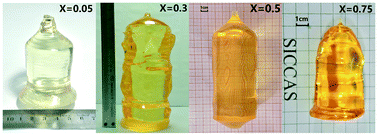Crystal growth of SmxY1−xCa4O(BO3)3 for piezoelectric applications at high temperature
Abstract
Various 2 inch SmxY1−xCa4O(BO3)3 (SmxY1−xCOB) crystals with good quality were grown successfully along the <010> axis by the Czochralski method. As the amount added increased, the unit cell dimensions for the obtained crystals were found to increase. At room temperature, the relative dielectric constants εE11/ε0, εE22/ε0 and εE33/ε0 were found to be 9.57, 11.87 and 9.58 for Sm0.05Y0.95COB, 9.66, 12.33 and 9.64 for Sm0.3Y0.7COB, 9.70, 12.78 and 9.75 for Sm0.5Y0.5COB, and 9.73, 14.10 and 10.14 for Sm0.75Y0.25COB, respectively. The electromechanical coupling factors and piezoelectric coefficients as a function of Sm content were studied, with maximum values found in the Sm0.75Y0.25COB crystal. All the as-grown crystals were observed to possess ultrahigh resistivities, and the values of the electrical resistivities of SmxY1−xCOB were approximately 1.1–3.1 × 108 Ω cm at 850 °C. In the range of the test temperature, the dielectric losses for the SmxY1−xCOB crystals were determined to be less than 45% at 840 °C, which together with the high thermal stability of the electromechanical and piezoelectric properties, with a variation of less than 5.5% at 850 °C, make the SmxY1−xCOB crystals important candidate materials for high-temperature piezoelectric applications.



 Please wait while we load your content...
Please wait while we load your content...